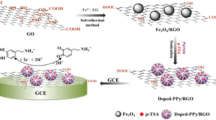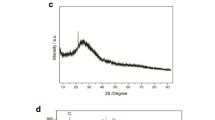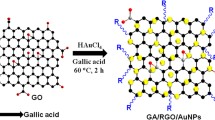Abstract
A novel sorbent consisting of magnetic oxidized nanocelluloses modified with graphene quantum dots was prepared and used for the separation and preconcentration of dopamine. The eluted dopamine from the sorbent was determined by a designed chemiluminescence system containing luminol, H2O2, Fe3+, and graphene quantum dots doped with nitrogen and phosphorus. Graphene quantum dots cause an increase in the intensity of the chemiluminescence system of luminol-H2O2, but the presence of Fe3+ ions in this system decreases its intensity because of the sorption of the Fe3+ ions on the surface of P, N-graphene quantum dots. However, the addition of dopamine resulted in the retrieval of P, N-graphene quantum dots, as well as the chemiluminescence intensity, due to the formation of its complex with Fe3+. The sorbent made of magnetic oxidized nanocelluloses modified with graphene quantum dots was characterized by various analytical techniques, and the effective parameters on the extraction of dopamine were investigated and optimized. Under the optimized conditions, the method displayed good linearity in the concentration range 0.25–17.5 µg L−1 for dopamine (R2 = 0.9918) with a limit of detection of 0.054 µg L−1. The intra- and inter-day relative standard deviations at a 10.0 µg L−1 concentration level of dopamine (n = 6) were 2.6 and 4.1%, respectively. This method was successfully applied to the extraction and determination of dopamine in human serum and urine samples.
Graphical abstract






Similar content being viewed by others
References
Perry M, Li Q, Kennedy RT (2009) Review of recent advances in analytical techniques for the determination of neurotransmitters. Anal Chim Acta 653:1–22
Li N, Guo JZ, Liu B, Cui H, Mao LQ, Lin YQ (2009) Determination of monoamine neurotransmitters and their metabolites in a mouse brain microdialysate by coupling high-performance liquid chromatography with gold nanoparticle-initiated chemiluminescence. Anal Chim Acta 645:48–55
Wang Y, Li YM, Tang LH, Lu J, Li JH (2009) Application of graphene-modified electrode for selective detection of dopamine. Electrochem Commun 11:889–892
Kim YR, Bong S, Kang YJ, Yang Y, Mahajan RK, Kim JS, Kim H (2010) Electrochemical detection of dopamine in the presence of ascorbic acid using graphene modified electrodes. Biosens Bioelectron 25:l2366-12369
Zheng Y, Wang Y, Yang X (2011) Aptamer-based colorimetric biosensing of dopamine using unmodified gold nanoparticles. Sens Actuators B Chem 156:95–99
Liu H, Li N, Zhang H, Zhang F, Su X (2018) A simple and convenient fluorescent strategy for the highly sensitive detection of dopamine and ascorbic acid based on graphene quantum dots. Talanta 189:190–195
Zhao C, Jiao Y, Hua J, Yang J, Yang Y (2018) Hydrothermal synthesis of nitrogen-doped carbon quantum dots as fluorescent probes for the detection of dopamine. J fluoresce 28:269–276
Liu X, Zhang W, Huang L, Hu N, Liu W, Liu Y, Li S, Yang C, Suo Y, Wang J (2018) Fluorometric determination of dopamine by using molybdenum disulfide quantum dots. Microchim Acta 185:1–8
Duan H, Li L, Wang X, Wang Y, Li J, Luo C (2015) A sensitive and selective chemiluminescence sensor for the determination of dopamine based on silanized magnetic graphene oxide-molecularly imprinted polymer. Spectrochim Acta - A: Mol Biomol Spectrosc 139(2015):374–379
Gao W, Qi L, Liu Z, Majeed S, Kitte SA, Xu G (2017) Efficient lucigenin/thiourea dioxide chemiluminescence system and its application for selective and sensitive dopamine detection. Sens Actuators B Chem 238:468–472
He L, Yang H, Xiao P, Singh R, He N, Liu B, Li Z (2017) Highly selective, sensitive and rapid detection of Escherichia coli O157:H7 using duplex PCR and magnetic nanoparticle-based chemiluminescence assay. J Biomed Nanotechnol 13:1243–1252
Song H, Su Y, Zhang L, Lv Y (2019) Quantum dots-based chemiluminescence probes: an overview. Luminescence 34:530–543
Amjadi M, Manzoori JL, Hallaj T, Sorouraddin MH (2014) Strong enhancement of the chemiluminescence of the cerium (IV)-thiosulfate reaction by carbon dots, and its application to the sensitive determination of dopamine. Microchim Acta 181:671–677
Zhang L, Z. Tang Z, Y. Dong Y (2018) Silicon quantum dot involved luminol chemiluminescence and its sensitive detection of dopamine. Anal Methods 10: 4129-4135.
Afsharipour R, Haji Shabani AM, Dadfarnia S, Kazemi E (2020) Selective fluorometric determination of sulfadiazine based on the growth of silver nanoparticles on graphene quantum dots. Microchim Acta 187:1–8
Afsharipour R, Dadfarnia S, Haji Shabani AM, Kazemi E, Pedrini A, Verucchi R (2021) Fabrication of a sensitive colorimetric nanosensor for determination of cysteine in human serum and urine samples based on magnetic-sulfur, nitrogen graphene quantum dots as a selective platform and Au nanoparticles. Talanta 226:122055
Ye M, Lin B, Yu Y, Li H, Wang Y, Zhang L, Cao Y, Guo M (2020) A ratiometric fluorescence probe based on graphene quantum dots and o-phenylenediamine for highly sensitive detection of acetylcholinesterase activity. Microchim Acta 187:1–1
Yu N, Peng H, Xiong H, Wu X, Wang X, Li Y, Chen L (2015) Graphene quantum dots combined with copper (II) ions as a fluorescent probe for turn-on detection of sulfide ions. Microchim Acta 182:2139–2146
Li L, Ji J, Fei R, Wang CZ, Lu Q, Zhang JR, Jiang LP, Zhu JJ (2012) A facile microwave avenue to electrochemiluminescent two-color graphene quantum dots. Adv Funct Mater 22:2971–2979
Anh NT, Chowdhury AD, Doong RA (2017) Highly sensitive and selective detection of mercury ions using N, S-codoped graphene quantum dots and its paper strip based sensing application in wastewater. Sens Actuators B Chem 252:1169–1178
Dey S, Govindaraj A, Biswas K, Rao C (2014) Luminescence properties of boron and nitrogen doped graphene quantum dots prepared from arc-discharge-generated doped graphene samples. Chem Phys Lett 595:203–208
Qu D, Zheng M, Du P, Zhou Y, Zhang L, Li D, Tan H, Zhao Z, Xie Z, Sun X (2013) Highly luminescent S N co-doped graphene quantum dots with broad visible absorption bands for visible light photocatalysts. Nanoscale 5:12272–12277
Hassanzadeh J, Khataee A (2018) Ultrasensitive chemiluminescent biosensor for the detection of cholesterol based on synergetic peroxidase-like activity of MoS2 and graphene quantum dots. Talanta 178:992–1000
Zhang L, Tang Z, Dong Y (2018) Silicon quantum dot involved luminol chemiluminescence and its sensitive detection of dopamine. Anal Methods 10:4129–4135
Dahaghin Z, Mousavi HZ, Sajjadi SM (2017) Synthesis and application of magnetic graphene oxide modified with 8-hydroxyquinoline for extraction and preconcentration of trace heavy metal ions. Chemistry Select 2:1282–1289
Jodeh S, Hamed O, Melhem A, Salghi R, Jodeh D, Azzaoui K, Benmassaoud Y, Murtada K (2018) Magnetic nanocellulose from olive industry solid waste for the effective removal of methylene blue from wastewater. Environ Sci Pollut Res 25:22060–22074
Yue Y, Zhou C, French AD, Xia G, Han G, Wang Q, Wu Q (2012) Comparative properties of cellulose nano-crystals from native and mercerized cotton fibers. Cellulose 19:1173–1187
Oun AA, Rhim JW (2017) Characterization of carboxymethyl cellulose-based nanocomposite films reinforced with oxidized nanocellulose isolated using ammonium persulfate method. Carbohydr Polym 174:484–492
Anirudhan TS, Rejeena SR (2013) Selective adsorption of hemoglobin using polymer-grafted-magnetite nanocellulose composite. Carbohydr Polym 93:518–527
Afsharipour R, Dadfarnia S, Haji Shabani AM, Kazemi E (2020) Design of a pseudo stir bar sorptive extraction using graphenized pencil lead as the base of the molecularly imprinted polymer for extraction of nabumetone. Spectrochim Acta-A: Mole Biomol Spectros 238:118427
Korbahti BK, Tanyolac A (2009) Continuous electrochemical treatment of simulated industrial textile wastewater from industrial components in a tubular reactor. J Hazard Mater 170:771–778
Zhu Q, Chen Y, Wang W, Zhang H, Ren C, Chen H, Chen X (2015) A sensitive biosensor for dopamine determination based on the unique catalytic chemiluminescence of metal-organic framework HKUST-1. Sens Actuators B Chem 210:500–507
Ye N, Gao T, Li J (2014) Hollow fiber-supported graphene oxide molecularly imprinted polymers for the determination of dopamine using HPLC-PDA. Anal Methods 6:7518–7524
Sun F, Chen F, Fei W, Sun L, Wu Y (2012) A novel strategy for constructing electrochemiluminescence sensor based on CdS-polyamidoamine incorporating electrodeposited gold nanoparticle film and its application. Sens Actuators B Chem 166:702–707
Author information
Authors and Affiliations
Corresponding authors
Ethics declarations
Conflict of interest
The authors declare no competing interests.
Additional information
Publisher's Note
Springer Nature remains neutral with regard to jurisdictional claims in published maps and institutional affiliations.
Supplementary Information
Below is the link to the electronic supplementary material.
Rights and permissions
About this article
Cite this article
Afsharipour, R., Dadfarnia, S. & Haji Shabani, A.M. Chemiluminescence determination of dopamine using N, P-graphene quantum dots after preconcentration on magnetic oxidized nanocellulose modified with graphene quantum dots. Microchim Acta 189, 192 (2022). https://doi.org/10.1007/s00604-022-05251-3
Received:
Accepted:
Published:
DOI: https://doi.org/10.1007/s00604-022-05251-3




